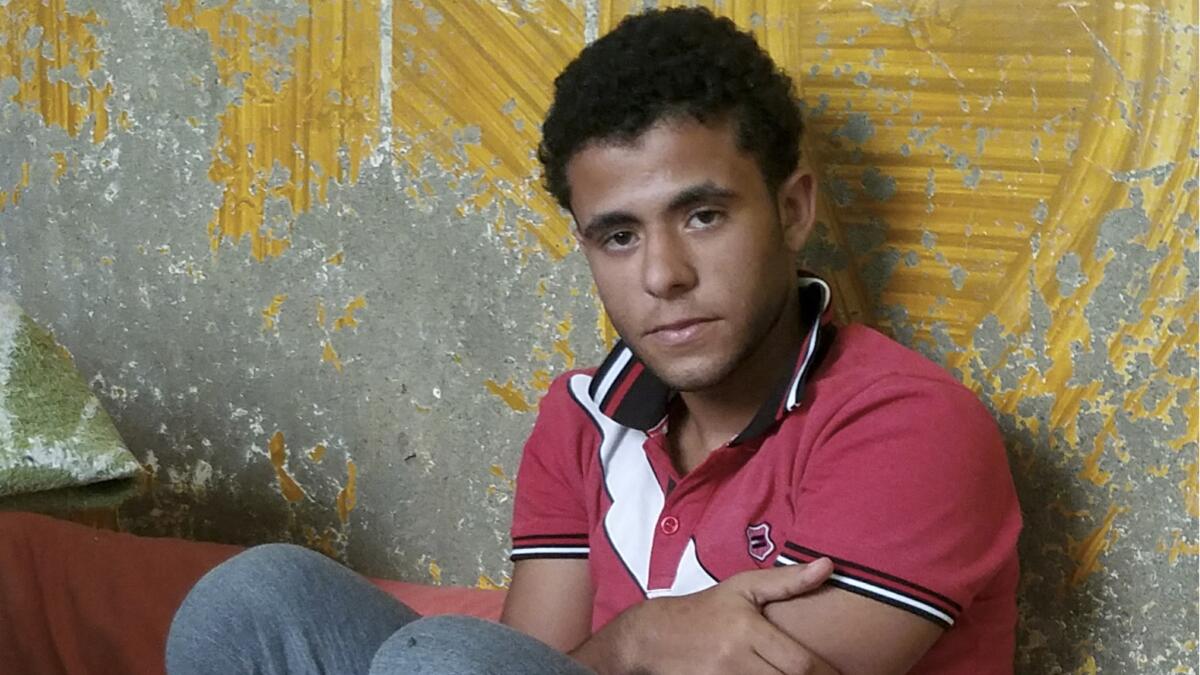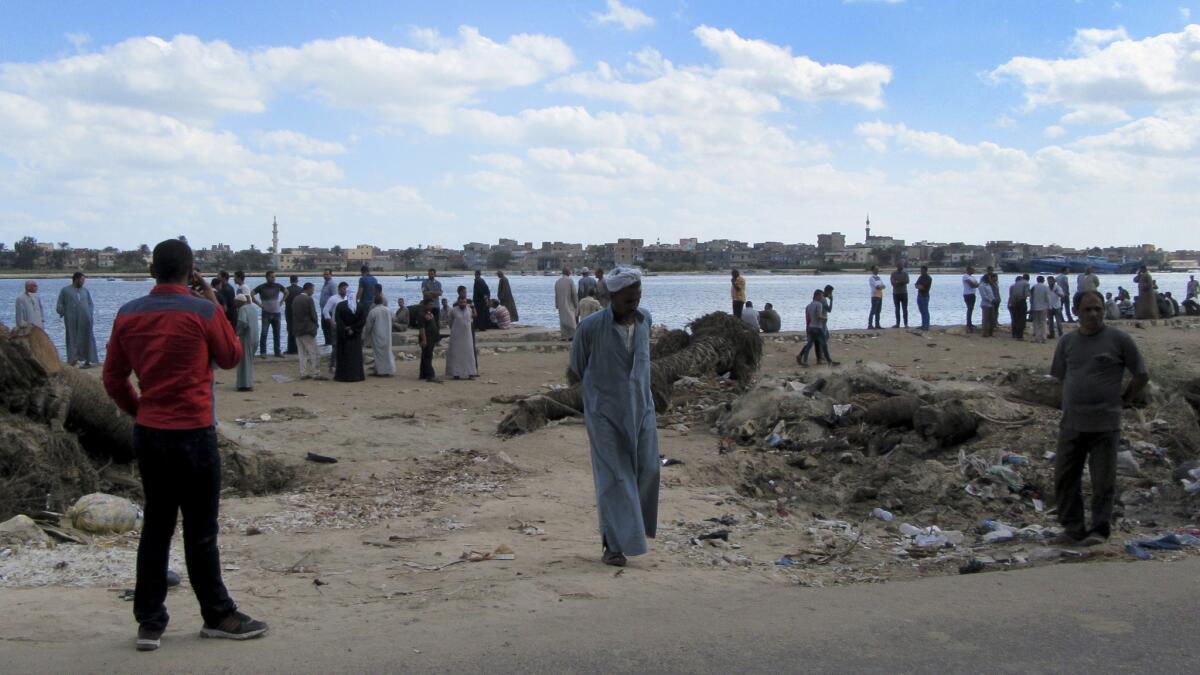Deaths on the Mediterranean Sea don’t keep migrants from trying to reach Europe

- Share via
Reporting from Rashid, Egypt — When the smuggler’s boat sank a dozen miles off Egypt’s Mediterranean coast, 17-year-old Attia Abdu Qamary fell into the choppy water with hundreds of other frightened migrants.
More than half looked like him -- teenage boys. Many had left their north coast fishing villages where the Nile River meets the sea in hopes of starting more promising lives in Italy, and sending desperately needed money home. Many had been traveling below deck in an area used for storing fish.
Attia, a wiry, strong swimmer, heard some of them cry out.
“Help me, I’m dying!”
Some clutched at him. Others sank into the depths. A friend at his side slipped away.
“I saw him go down,” Attia said later, eyes blank behind long lashes. “He was holding my hand.”

As migrants and refugees seek to escape poverty and violence in their homelands, the Mediterranean Sea crossing from North Africa to Italy has become among the busiest and deadliest, and the number of youths attempting the crossing has dramatically
As migrants and refugees seek to escape poverty and violence in their homelands, the Mediterranean Sea crossing from North Africa to Italy has become among the busiest and deadliest, and the number of youths attempting the crossing has dramatically increased, according to the United Nations Children’s Fund.
The journey has killed 3,165 migrants trying to reach Europe this year, on pace to exceed last year’s total of 3,771, according to officials at the Institute of Migration and the U.N. refugee agency, which has dubbed this the deadliest year on record in the Mediterranean.
Last year, more than a million migrants poured into Europe by sea, mostly Syrians fleeing civil war. The bulk traveled through Turkey across the Aegean Sea to Greece, where tens of thousands were stranded in makeshift camps.
Restrictions by Balkan countries and a European Union agreement with Turkey to return migrants to Turkey stemmed that flow, but 301,583 migrants have still reached Europe by sea this year, according to the U.N. Refugee Agency. Of those, 131,432 arrived in Italy, most on weeklong voyages from Africa, chiefly Nigerians and Eritreans.

Egypt has gained prominence as a point of origin, especially for youths, officials and analysts said. As of last month, the number of Egyptian unaccompanied minors reaching Italy by sea almost tripled compared with this time last year: 2,266, up from 854, according to the U.N. Refugee Agency.
Libyan officials this month announced that they had reached an agreement with Italy to fight illegal migration, which – along with the ongoing Libyan civil war - will probably funnel more Europe-bound migrants into Egypt.
Europe is an attractive destination for a booming population in Egypt, which is now home to 93 million people. Attia’s village has swelled to 35,000 people, many of them jobless youths with little education competing for scant low-paid work.
Over-fishing has left even experienced men unemployed for years. And now smugglers eager to spur quick business are stirring fears that Europe will soon close its doors, analysts said.
After the boat Attia was on capsized on Sept. 21, killing dozens — the death toll was more than 200 people by Tuesday as more bodies were found — and leaving many missing, the European Parliament chief called for Egypt’s aid to be tied to an agreement similar to the one reached with Turkey in March to limit migration to Europe.
Egypt’s parliament held an emergency session this week to prepare a law for consideration next month that would impose fines of up to $56,000 and potential life sentences on smugglers when migrants are killed or disabled.
Egyptian President Abdel Fattah Sisi, who has urged parliament to pass the law, assured the United Nations General Assembly this month that his administration has been working to reduce illegal migration.
“We are concerned and committed to safeguarding our borders and preventing this, but society must contribute to the effort so this is never repeated,” Sisi said Monday in a televised address.
He had a message for young would-be migrants: “Don’t leave your country and go, you can develop it if you will just join hands with us.”
Naela Gabr, a senior diplomat leading Egypt’s efforts to address illegal migration, worked on the proposed law.
“It won’t be the magic solution, but it will help,” she said. “The smugglers are knocking at their doors and telling them, ‘You can live in heaven.’”

Her office just completed a study examining 11 of the country’s 27 provinces that send the most young migrants abroad, and plans a media outreach campaign. She said developed countries also need to do more to encourage migration through legal channels.
“It’s not just about putting up tougher regulations,” said Sarah Crowe, a UNICEF spokeswoman. “As we’ve seen in the case of the Balkans, people are still coming through, they’re just using riskier routes.”
The Egyptian coast guard has tried to intercept smugglers’ boats in recent weeks, stopping several on the north coast carrying hundreds of migrants. Authorities said they have made 22 arrests related to the boat’s sinking last week, including the boat’s owner. Among them were seven crew members charged with human trafficking and manslaughter.
Ahmed Khamees, a north coast fisherman from Rashid, also known as Rosetta, said some smugglers buy old fishing boats for $20,000 to $30,000. They keep migrants in local stash houses, he said, using small dinghies to ferry them out to larger boats anchored off the coast.
Smugglers pack the shoddy boats with hundreds of people – far more than they were designed to carry -- for one-way journeys that can earn the smugglers hundreds of thousands of dollars.
Khamees, 34, has a 13-year-old son, and said he’s trying to keep him close by, choosing his friends carefully, but that may not be enough.
“There’s nothing to keep them here,” he said.
The deaths in the sinking last week upset many in Egypt, but failed to dampen the yearning among youths waiting near the pier, who showed Facebook photos and messages from friends who had made it to Italy, including tips about what to say in Italian upon arrival: “Mangiare.” Eat.
When he was 19, Mostafa Abu Amer, who lives in the northern village of Menoufia, paid a smuggler $3,000 to take him to Italy. After nine days at sea, he was rescued by the Red Cross, found work in Italy as a carpenter and became a legal resident. He married, built a house, and moved back to Egypt to raise his two children.
Now 28, he knows his success inspired his 16-year-old cousin to board the boat last week. The youth has not been heard from since.
“It’s worse now. We were only 150 on a 16-meter boat. This time they had hundreds,” Amer said as he awaited news near the pier.
He won’t give up the idea that he must go.
— Samya Ali, mother of Attia Abdu Qamary
Nearby, Ashraf Goma, 19, said he chats daily on social media with a 17-year-old friend in Italy who left their village in Faiyum province to the south six months ago. He said his friend now wears silver chains, attends school, has been adopted by an Italian family and is about to become a legal resident.
“When I ask, ‘Aren’t you coming back?’ he says, ‘What for?’” Goma said.
Goma’s older brother tried to migrate to Italy through Libya recently but was arrested. His 15-year-old brother was on the boat that sank, and was still missing. Goma said the smuggler who arranged his brother’s passage has been in business in their village for 16 years, and started by sending his own children.
Goma was going to board a smuggler’s boat six months ago, but reconsidered. It disappeared, and scores of migrants remain missing. Now he is desperate for news of his younger brother. Some survivors said they saw him after the boat sank. Others said they saw his body.
Goma remembers the last time they talked. The family had signed a promissory note to pay the smuggler about $4,000 for his brother’s trip.
“He was joking with me, saying ‘I’m not coming back to you,’” Goma said, adding that his brother knew the risks.
Goma pointed to an elderly man sorting dates beneath a palm tree for a few dollars per day.
“What can a young man like me do with $4 to $5 a day?” he said. “If I stay here in Egypt, I could never earn a good living, I could never get married.”
Friends who made it to Italy post on social media about attending school. As they send money home, their families’ red brick houses sprout satellite dishes, ornate plaster balconies, carved wood doors and rebar reaching ever skyward as they add stories.
Rarely are youths turned back from Italy, which has laws barring their involuntary deportation.
In Green Island, Ahmed Afandi said his 17-year-old brother was sent back last year only because authorities suspected he was 18. He immediately asked for help going again, but Afandi, 24 – who earns as little as $2.50 a day driving a van he doesn’t own – refused.
Their teenage cousin was on the boat that sank last week and was still missing.

Attia spent eight hours in the sea before fishermen saved him, making him among about 160 people who survived. Now his mother, Samya Ali, 36, fears her son will try again despite the tragedy.
“He won’t give up the idea that he must go,” she said.
Attia had signed a promissory note to pay a smuggler $2,000. When the boat capsized, he didn’t have to pay. He could try another boat.
He pulled out his father’s medical bills. His father has Hepatitis C, hasn’t worked in a decade and needs $110 a week for medication.
“I told my father I’m going to get you enough money for treatment,” Attia said.
Attia’s family of five shares three rooms. He wears a worn red polo shirt and sweatpants and drives a “toc toc” mini-cab for $2 a day.
His uncle, Ghabour Qamary, 43, who the teenager called for help as the smuggler’s boat was sinking, also thinks Attia should try to leave Egypt again.
“If I had the chance myself, I would go. I’m dead anyway, here or in the sea,” said the fisherman, standing outside Attia’s house in his thin green jalabiya robe, his forehead marked with the dark zabeeba spot that comes from frequent prayer.
He pointed to his two wide-eyed sons flanking him, Fahd, 9, and Saif, 8.
“I will send them,” he said.
UPDATES:
2:15 p.m.: This article has been updated with additional arrests.
It was originally published at 5 p.m. Sept. 27.
More to Read
Sign up for Essential California
The most important California stories and recommendations in your inbox every morning.
You may occasionally receive promotional content from the Los Angeles Times.











